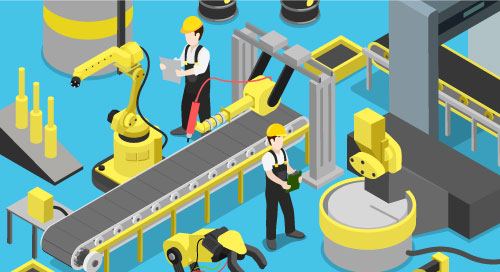Digital Experiments Prove Smart Factory Solutions

Some 60 percent of IIoT initiatives stall at the proof-of-concept stage, and only 26 percent of companies have had a deployment they considered a complete success. That’s the conclusion of a global survey of 1,845 IT and business decision-makers across a range of verticals, including manufacturing, transportation, and energy.
Unfortunately, these companies lack a clear understanding of how their initiatives relate to the problem they’re trying to solve. No surprise that they spend great sums of money on deployments that don’t deliver meaningful outcomes. What’s needed is a process that lets businesses take the guesswork out of the equation by applying scientific testing to a specific problem.
Assure IIoT Success with Digital Experiments
A new approach using digital experimentation quickly establishes which ideas are worthwhile and which are not. This method uses minimal resources, and can lead to the best path forward to resolve a company’s greatest pain point.
A digital experiment tests complex scenarios using multiple components, standards, IIoT and edge technologies, data types, and vendors. The results strengthen management’s confidence in IT and operational technology, and demonstrate the value of investing in proven IIoT and edge initiatives.
The process brings IT and OT groups together by aligning assets and enabling them to work in tandem to solve manufacturing and other industrial challenges as well as advance business opportunities.
In this way, manufacturers can determine how a particular IIoT project will improve efficiency and productivity, or reduce costs, before spending significant time and money in deployment. Read People, Technology Power Machine Uptime for more about organization-wide collaboration.
Discovering What Works at the Edge
One company doing interesting work in this area is ADLINK. Its solution, known as ADLINK Digital Experiments, enables businesses to rapidly and cost-effectively test hypotheses on how IIoT deployments can solve a variety of challenges before the solution is rolled out (Figure 1).

Lawrence Ross, GM at ADLINK IoT Solutions & Technology, described digital experiments as a funded proof of concept (PoC), and said, “Customers typically are the experts in their processes and assets. They can describe the problem, but they don’t know how to arrive at a hypothesis. We help them understand how to scientifically approach an IIoT PoC and design a low-cost, controlled experiment to validate it.”
Creating new revenue streams and products—all backed by data—are also among the things that manufacturers can test. Another benefit is that experiments provide facts that can anchor the excitement about a company’s decisions.
Lower the Barrier to Entry
Spending time and money on analyzing an entire process, hoping that results will somehow emerge, is an inefficient way to conduct IIoT R&D. Instead, concentrating on a single pain point will more likely prove valuable.
“Our effort is to reduce risk by evaluating whether the technology that exists today can solve their specific business problem,” said Ross, “and if so, how to deploy it at a lower cost.” Watch the video below to see how companies can test IoT use cases before deploying technology factory-wide.
Hard Data for a Soft Drink Company
To illustrate how a manufacturer can use digital experiments, imagine the challenges a soft drink manufacturer could face. Bottling is a high-speed, low-margin business. Their profitability depends on preventing interruptions to their production line. If one machine consistently malfunctions, that’s where to conduct a digital experiment.
A bottling company in the Middle East had exactly this problem and turned to ADLINK to run a PoC. Richard Allan, SVP EMEA Sales at ADLINK IoT Solutions & Technology, said, “Their labeling machine would not work properly if the temperature and humidity rose above a certain level. The labels wouldn’t stay on the bottles, bringing their entire production to a halt.”
ADLINK proposed how to test a hypothesis through a digital experiment. The results demonstrated that the most cost-effective way to solve the problem was to combine a simple technique with automation. By automatically reducing the speed of the production line when the temperature and humidity reached specific levels, the machine could work effectively in less than optimum conditions.
“It’s much better to slow down than stop production,” said Allan. “And then speed up again when the situation allows it.”
The experiment also showed the bottler not only how to automate its production line using temperature and humidity data analytics, but to do so with the fewest sensors, IIoT devices, and software.
A Digital Experiment Toolbox
What ADLINK offers is not a kit. “What we bring is more of a toolbox,” said Ross. “It includes all the technology needed to validate a hypothesis.”
To conduct a digital experiment, ADLINK supplies an assortment of ADLINK and third-party cameras, gateway devices, and sensors. Most, if not all of them, run on Intel® processors, as does the majority of the IIoT equipment that’s recommended post-experiment. Some tests may require specialty sensors, such as a high-resolution accelerometer, which can be included on a case-by-case basis. They then connect to existing OT data sources using Modbus, BACnet, or nearly any existing OT protocols.
“Connecting and streaming data is the first thing we do in an experiment before any analysis is performed,” said Ross. “We provide all of the equipment to do that and partner with different cloud providers like Microsoft Azure, AWS, and Google for the analytics and data science.” In addition, ADLINK works with companies that specialize in edge data analytics, such as FogHorn and SAS.
Once the experiment is run, the business receives the information it needs to replicate the results using minimal equipment, sensors, devices, and software. This enables the manufacturer to quickly and economically roll out a validated IIoT solution, which delivers the amount of computing power needed, across the factory floor.
For both developers and manufacturers, the key lesson is to first identify the greatest operational disruptions. Only then should they define a hypothesis and set up a test. In that way, they can determine how the IIoT will address their needs before installing any technology.